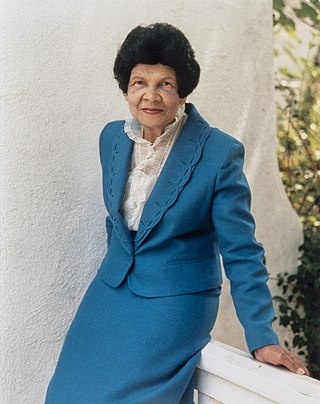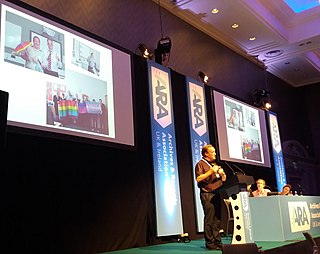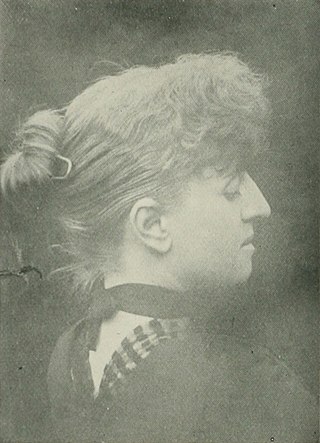Related Research Articles

A librarian is a person who works professionally in a library providing access to information, and sometimes social or technical programming, or instruction on information literacy to users.

The Los Angeles Public Library system (LAPL) is a public library system in Los Angeles, California. The system holds more than six million volumes, and with around 19 million residents in the Greater Los Angeles area, it serves the largest metropolitan population of any public library system in the United States. The system is overseen by a Board of Library Commissioners with five members appointed by the mayor of Los Angeles in staggered terms, and operates 72 library branches throughout the city. In 1997 a local historian described it as "one of the biggest and best-regarded library systems in the nation." It is not to be confused with the LA County Library system which operates several library branches across certain areas of Los Angeles County.

Charles Fletcher Lummis was a United States journalist, and an activist for Native American rights and historic preservation. A traveler in the American Southwest, he settled in Los Angeles, California, where he also became known as a historian, photographer, ethnographer, archaeologist, poet, and librarian. Lummis founded the Southwest Museum of the American Indian.

Mary Emily Foy was the first woman head librarian of the Los Angeles Public Library, appointed to the job in 1880 at the age of 18. She had graduated the year before from Los Angeles High School. She served for only four years but left a legacy for Los Angeles librarians to remember.
Suzanne Lummis is a poet, influential teacher, arts organizer and impresario in Los Angeles. She is associated with the poem noir, as well as the sensibility for which she is a major exponent–a literary incarnation of performance poetry–the Stand-up Poetry of the 80s and 90s. She is also grouped with “The Fresno Poets.”

Adelaide Rosalie Hasse is listed as one of the "100 most important leaders we had in the 20th century" in the December 1999 edition of American Libraries. She is credited with having developed the Superintendent of Documents Classification system used by the Government Printing Office and Federal Depository Library Program.

Clara Stanton Jones was the first African-American president of the American Library Association, serving as its acting president from April 11 to July 22 in 1976 and then its president from July 22, 1976, to 1977. Also, in 1970 she became the first African American and the first woman to serve as director of a major library system in America, as director of the Detroit Public Library.

Yolanda Retter was an American lesbian activist, librarian, archivist, and author.

Miriam Matthews was an American librarian, advocate for intellectual freedom, historian, and art collector. In 1927, Matthews became the first credentialed African American librarian to be hired by the Los Angeles Public Library.

The field of library science seeks to provide a diverse working environment in libraries. Ways to change the status quo include diversifying the job field with regards to age, class, disabilities, ethnicity, gender identity, race, sex, and sexual orientation.

Althea Hester Warren was the director of the Los Angeles (California) Public Library from 1933 to 1947 and president of the American Library Association in 1943-1944. She was inducted into the California Library Association's Library Hall of Fame in 2013.

Rachel Davis Harris was an American librarian and activist. She was an influential female African American director and children's librarian of the Louisville Free Public Library, Western Colored Branch, one of the first segregated libraries built in the southern United States. She promoted library outreach to youths and equitable access to library services in the black community during the Jim Crow era.

Essae Martha Culver was an American librarian, the first state librarian of Louisiana and president of the American Library Association.
This is a timeline of women in library science throughout the world.

Tessa Kelso was an American publicist, journalist, and head librarian of the Los Angeles Public Library. A local Methodist minister accused her of "sin" when the library stocked a book that offended him. She sued him for malicious slander, and the case was settled in her favor, in 1895.
Gladys Cox Hansen was an American librarian, archivist and author. She was an expert on the history of San Francisco and the 1906 San Francisco earthquake.

Dorothea Rhodes Lummis Moore was an American physician, writer, newspaper editor, and activist. Although a successful student of music in the New England Conservatory of Music, in Boston, she entered the medical school of Boston University in 1881, and graduated with honors in 1884. In 1880, she married Charles Fletcher Lummis, and in 1885, moved to Los Angeles, California, where she began practicing medicine. She worked as dramatic editor, musical editor, and critic at the Los Angeles Times. She was instrumental in the formation of a humane society which was brought about through her observations of the neglect and cruelty to the children of the poor, and Mexican families, visited in her practice; and the establishment of the California system of juvenile courts.

Joyce Annette Madkins Sumbi was an American librarian. She was the first African-American administrator in the LA County Library system.
John F. Szabo is an American librarian, library executive, and the twentieth City Librarian of Los Angeles, the chief executive of the Los Angeles Public Library. He previously served as the Director of the Atlanta-Fulton Public Library System, Clearwater (FL) Public Library System, Palm Harbor (FL) Public Library, and the Robinson (IL) Public Library District. In 2015, the Los Angeles Public Library won the National Medal for Museum and Library Service, the nation's highest honor for a library or museum. Awarded by the Institute for Museum and Library Services (IMLS), the medal was presented by First Lady Michelle Obama at a White House ceremony.

Richard J. Riordan Central Library, also known as the Los Angeles Central Library, is the main branch of the Los Angeles Public Library (LAPL), in Downtown Los Angeles. It is named after Mayor of Los Angeles Richard Riordan.
References
- 1 2 3 Beyelia, Nicholas. "The Great Library War of 1905, Part 1: Have you met Miss Jones?". Los Angeles Public Library. LAPL Blogs. Retrieved 1 May 2019.
- ↑ Kenneth A. Breisch (2016). The Los Angeles Central Library: Building an Architectural Icon, 1872–1933. Getty Publications. pp. 23–24. ISBN 9781606064900.
- ↑ Beyelia, Nicholas. "The Great Library War of 1905, Part 3: The Firing of Mary Jones". LAPL. LAPL Blogs. Retrieved 1 May 2019.
- ↑ Hansen (2017). "Library Wars: The Making of Librarianship at the Los Angeles Public Library, 1890–1910". Libraries: Culture, History, and Society. 1 (1): 97–125. doi:10.5325/libraries.1.1.0097. JSTOR 10.5325/libraries.1.1.0097.
- 1 2 Holland, Michael (27 May 2015). "The Archivist Files: Why the woman who started LA's branch libraries was fired". Off-Ramp. KPCC. Retrieved 1 May 2019.